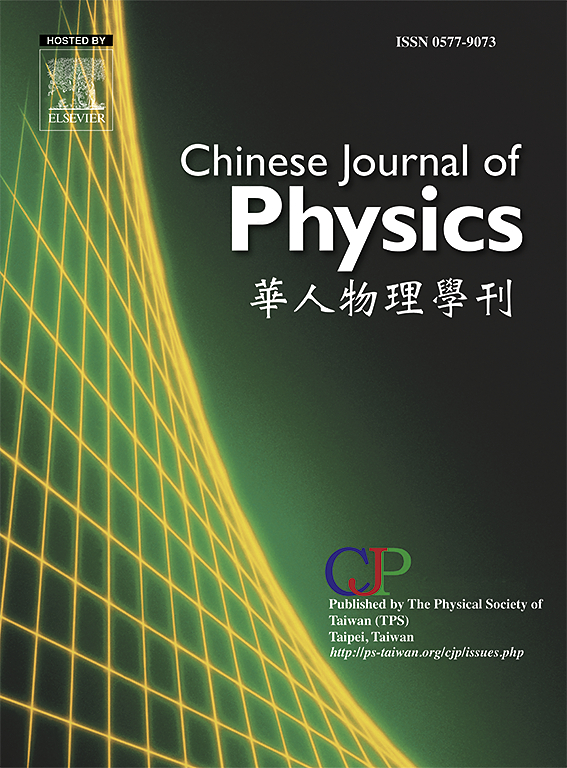非对称全硅光子晶体板连续介质中的三重Friedrich-Wintgen束缚态
IF 4.6
2区 物理与天体物理
Q1 PHYSICS, MULTIDISCIPLINARY
引用次数: 0
摘要
在这项研究中,我们介绍了一种在太赫兹全硅光子晶体(PhC)中实现F-W bic的技术,该技术还实现了电磁感应透明(EIT)。通过采用具有圆柱孔阵列的对称PhC,我们可以在电偶极子支持的连续介质中创建对称保护的束缚态(SP BIC)。当C2v对称性被打破时,BIC演化为准sp BIC。通过调整不对称参数,准BIC通过相消干涉耦合到导模共振(GMR),并转化为F-W BIC。由于这些参数的变化,两种模式在强耦合和弱耦合之间经历了多次转换,从而产生了三个F-W bic。此外,我们表明,在第三个F-W BIC中,与BIC条件的轻微偏差会触发EIT。我们成功地在太赫兹PhC中实现了三个F-W BICs,并通过调整不对称参数α在模式耦合区观察到独特的模式恢复现象。在第三个BIC偏差点,我们实现了主要受电四极(EQ)影响的EIT,并发现改变矩形孔宽度L和板厚t可以独立控制EIT。本文章由计算机程序翻译,如有差异,请以英文原文为准。

Triple Friedrich–Wintgen bound states in the continuum in asymmetric all–silicon photonic crystal slabs
In this research, we introduce a technique for achieving F–W BICs in terahertz all–silicon photonic crystals (PhC), which also enables Electromagnetically induced transparency (EIT). By employing a symmetric PhC featuring an array of cylindrical holes, we can create a symmetry–protected bound state in the continuum (SP BIC) supported by an electric dipole. When the C2v symmetry is broken, the BIC evolves into a quasi–SP BIC. By adjusting the asymmetry parameters, quasi–BIC couples to guided mode resonance (GMR) via destructive interference and transforms into F–W BIC. As these parameters are varied, the two modes undergo multiple transitions between strong and weak coupling, resulting in the emergence of three F–W BICs. Additionally, we show that at the third F–W BIC, a slight deviation from the BIC conditions triggers EIT. We have successfully realized three F–W BICs in terahertz PhC and observed a distinctive mode recovery phenomenon in the mode coupling region by adjusting the asymmetry parameter α. At the third BIC deviation point, we achieved EIT primarily influenced by electric quadrupoles (EQ) and found that altering the rectangular hole width L and plate thickness t can independently control EIT.
求助全文
通过发布文献求助,成功后即可免费获取论文全文。
去求助
来源期刊

Chinese Journal of Physics
物理-物理:综合
CiteScore
8.50
自引率
10.00%
发文量
361
审稿时长
44 days
期刊介绍:
The Chinese Journal of Physics publishes important advances in various branches in physics, including statistical and biophysical physics, condensed matter physics, atomic/molecular physics, optics, particle physics and nuclear physics.
The editors welcome manuscripts on:
-General Physics: Statistical and Quantum Mechanics, etc.-
Gravitation and Astrophysics-
Elementary Particles and Fields-
Nuclear Physics-
Atomic, Molecular, and Optical Physics-
Quantum Information and Quantum Computation-
Fluid Dynamics, Nonlinear Dynamics, Chaos, and Complex Networks-
Plasma and Beam Physics-
Condensed Matter: Structure, etc.-
Condensed Matter: Electronic Properties, etc.-
Polymer, Soft Matter, Biological, and Interdisciplinary Physics.
CJP publishes regular research papers, feature articles and review papers.
 求助内容:
求助内容: 应助结果提醒方式:
应助结果提醒方式:


